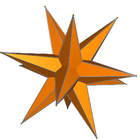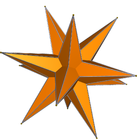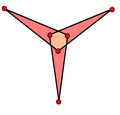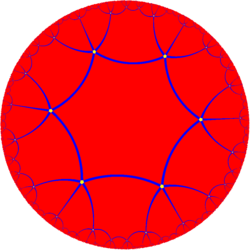Great triambic icosahedron: Difference between revisions
mNo edit summary |
No edit summary |
||
| Line 31: | Line 31: | ||
|colspan=3 valign=top align=center|[[File:Ninth stellation of icosahedron facets.png|240px]]<BR>[[Stellation diagram]] |
|colspan=3 valign=top align=center|[[File:Ninth stellation of icosahedron facets.png|240px]]<BR>[[Stellation diagram]] |
||
|} |
|} |
||
In [[geometry]], the '''great triambic icosahedron''' and '''medial triambic icosahedron''' are a visually identical [[Dual polyhedron|dual]] [[uniform polyhedra]]. The exterior surface also represents |
In [[geometry]], the '''great triambic icosahedron''' and '''medial triambic icosahedron''' are a visually identical [[Dual polyhedron|dual]] [[uniform polyhedra]]. The exterior surface also represents the [[The Fifty-Nine Icosahedra|'''De<sub>1</sub>f<sub>1</sub>''']] [[Great_triambic_icosahedron#As_a_stellation|stellation]] of the [[icosahedron]]. The only way to differentiate these two polyhedra is to mark which intersections between edges are true [[vertex|vertices]] and which are not. In the above images, true vertices are marked by gold spheres. |
||
The 12 vertices of the [[convex hull]] matches the [[vertex arrangement]] of an [[icosahedron]]. |
The 12 vertices of the [[convex hull]] matches the [[vertex arrangement]] of an [[icosahedron]]. |
||
Revision as of 09:18, 30 August 2011
| Great triambic icosahedron | Medial triambic icosahedron | |

|

| |
| Types | Dual uniform polyhedra | |
| Symmetry group | Ih | |
| Name | Great triambic icosahedron | Medial triambic icosahedron |
| Index references | DU47, W34, 30/59 | DU41, W34, 30/59 |
| Elements | F = 20, E = 60 V = 32 (χ = -8) |
F = 20, E = 60 V = 24 (χ = -16) |
| Isohedral faces |  |

|
| Duals |  Great ditrigonal icosidodecahedron |
 Ditrigonal dodecadodecahedron |
| Stellation | ||
| Icosahedron: W34 | ||
 Stellation diagram | ||
In geometry, the great triambic icosahedron and medial triambic icosahedron are a visually identical dual uniform polyhedra. The exterior surface also represents the De1f1 stellation of the icosahedron. The only way to differentiate these two polyhedra is to mark which intersections between edges are true vertices and which are not. In the above images, true vertices are marked by gold spheres.
The 12 vertices of the convex hull matches the vertex arrangement of an icosahedron.
Great triambic icosahedron
The great triambic icosahedron is the dual of the great ditrigonal icosidodecahedron, U47. It has 20 inverted-hexagonal faces, shaped like a three-bladed propeller. It has 32 vertices: 12 exterior points, and 20 hidden inside. It has 60 edges.
Medial triambic icosahedron
The medial triambic icosahedron is the dual of the ditrigonal dodecadodecahedron, U41. It has 20 faces, each being simple concave isogonal hexagons. It has 24 vertices: 12 exterior points, and 12 hidden inside. It has 60 edges.
A feature the medial triambic icosahedron does not share with the great triambic icosahedron is that the medial triambic icosahedron is topologically a regular polyhedron of index two.[1] By distorting the triambi into regular hexagons, one obtains the hyperbolic order-5 hexagonal tiling:
As a stellation
It is Wenninger's 34th model in his 9th stellation of the icosahedron
See also
References
- Wenninger, Magnus (1974). Polyhedron Models. Cambridge University Press. ISBN 0-521-09859-9.
- Wenninger, Magnus (1983). Dual Models. Cambridge University Press. ISBN 978-0-521-54325-5. MR730208.
- ^ The Regular Polyhedra (of index two), David A. Richter
External links
- Weisstein, Eric W. "Great triambic icosahedron". MathWorld.
- Weisstein, Eric W. "Medial triambic icosahedron". MathWorld.
- gratrix.net Uniform polyhedra and duals
- bulatov.org Medial triambic icosahedron Great triambic icosahedron


